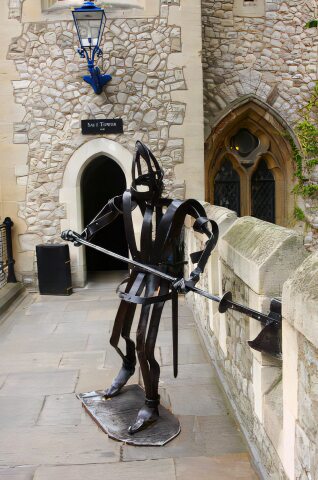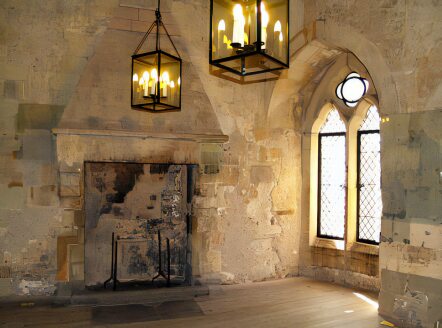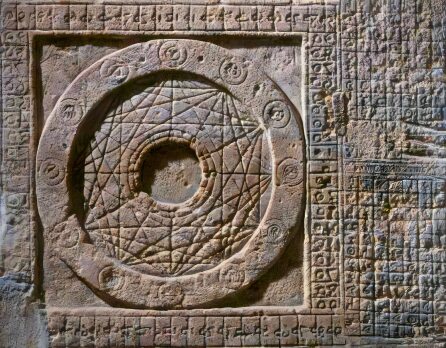Tower of London
The Salt Tower, one of the 21 towers which make up the Tower of London complex, was built in the late 1230s and is part of King Henry III's curtain wall which surrounds the fortress. Built on the Tower's south-eastern corner, the Salt Tower overlooked the River Thames.
The Salt Tower was initially known as Julius Caesar's Tower and later as Baliol's Tower. It is possible that the tower came to be referred to as the 'Salt Tower' as in medieval England salt was extremely expensive and could only be afforded by the higher nobility.
Salt Tower
The Lords sat on the dais at the 'high table' while their commoner servants at lower trestle tables. The salt was placed in the centre of the high table and only those of the appropriate rank were able to use it. Those less favoured on the lower tables were "beneath the salt". It is possible that salt was traditionally stored in this tower.
Inside the tower has a basement with dungeons and two storeys with an inserted upper floor. The ground floor of the Salt Tower provided storage, upstairs is a pentagonal shaped chamber with a huge thirteenth century stone fireplace and decorative window. The room has many examples of graffiti made by prisoners. At present, it contains a display showing the different kinds of treatment received by the prisoners who were held there.
Salt Tower Interior
Prisoners held in the Salt Tower include King John Balliol, set up as a puppet King of Scots by King Edward I, Balliol was crowned at Scone in 1292. His reign was short and difficult as he was caught between Edward I and the Scottish nobles who humiliated him and he became referred to as Tom Tabbard (‘Empty Coat’). The Scottish lords took power into their own hands and in 1295 allied with Philip of France. This precipitated a clash with Edward who invaded Scotland in 1296 and stripped John Balliol of his power.
Imprisoned in the Tower for three years, Balliol was eventually released from the Tower and allowed to go to his family estates at Bailleu, France in July 1299, where he remained until his death in April 1313 at the age of 63.
Astronomical clock of Hew Draper, Bristol Innkeeper, in the Salt Tower
Hew Draper, a Bristol innkeeper who was accused of practising sorcery, was imprisoned in the Salt Tower in 1561 for an accusation of witchcraft against Bess of Hardwick, and her husband Sir William St. Lo. Draper claimed that although he had been interested in magic, he had burnt all his magical books but he carved a huge, incredibly intricate, astronomical clock which can still be seen today.
The inscription records that "Hew Draper of Brystow made this sphere the 30 daye of Maye anno 1561". When he carved this chart upon the wall of his cell, Draper was noted to be very sick and it is positioned low upon the wall as if done by a man sitting on the floor.
Jesuits were also imprisoned in the Salt Tower and their carvings depicting religious scenes can also be seen on the walls, in several places a pierced heart, hand, and foot have been carved. This symbol signifies the wounds of Christ. there are several inscriptions marked by the IHS monogram, with a cross above the H, a form commonly used by members of the Society of Jesus. The inscribed name of Michael Moody, 1587, recalls a plot to murder Queen Elizabeth.
The Jesuit Priest John Gerard was imprisoned in the Salt Tower and questioned and tortured by being repeatedly suspended from chains on the dungeon wall. Gerard managed a daring escape from the Salt Tower, with aid from other members of the Catholic underground, Gerard, along with John Arden, escaped on a rope strung across the Tower moat during the night of 4 October 1597. Even though his hands were still mangled from the tortures he had undergone, he succeeded in climbing down. He reached Rome, where he lived in exile for the rest of his life. Henry Walpole, a young Jesuit was imprisoned in the Salt Tower in 1593 and engraved his name on its walls, despite being racked many times, he refused to provide the information the authorities required. In 1595 he was taken to York, where he was tried and executed, probably by being burned alive.
Giovanni Battista Castiglione, an Italian tutor who used to carry Princess Elizabeth's private letters to her when she was imprisoned in the Tower also suffered a term of imprisonment there.
The exterior and windows and windows of the Salt Tower were restored by the Victorian architect Anthony Salvin in 1857-8.
Traitor's Gate PreviousNext The Devereux Tower
